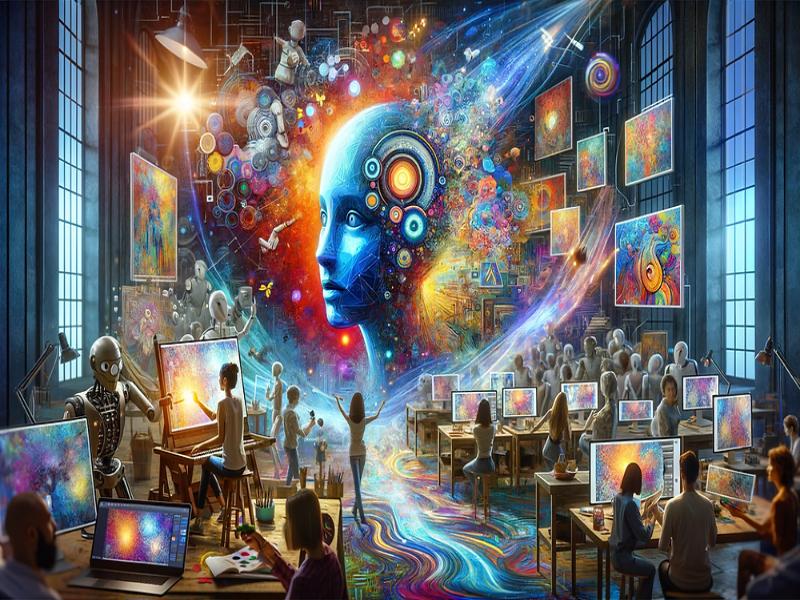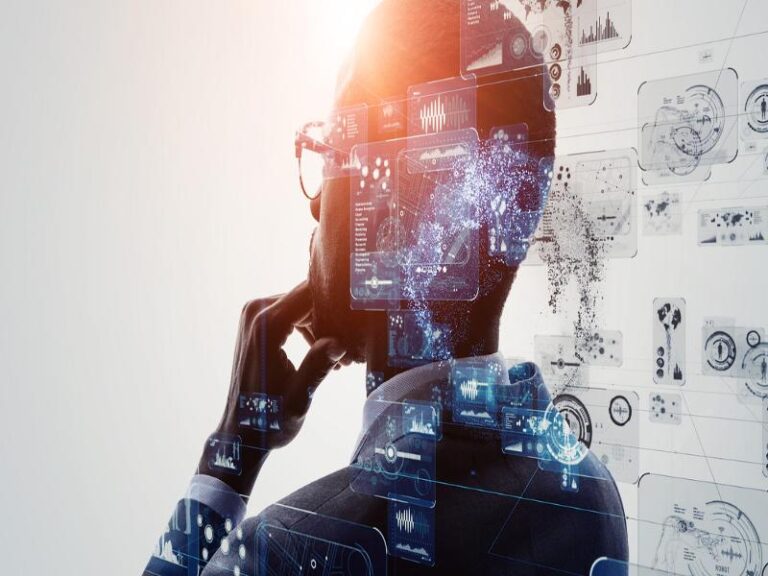Intersection of Art and Technology ( Creative Possibilities)
Did you know that art and technology are converging in ways that have never been seen before? The synergy between these two unlikely bedfellows is creating a wealth of creative possibilities that are redefining the way we experience art.
The future of art and technology holds tremendous potential for innovative forms of expression that push the boundaries of our imagination.
Intersection of Art and Technology
In this guide, we will dive into the intersection of art and technology, exploring how this fusion is transforming the artistic landscape and shaping the future of creative expression.
From digital art and virtual reality experiences to interactive installations and AI-generated masterpieces, we will uncover the exciting ways in which artists are leveraging technology to revolutionize the art world.
Join us on this journey to discover the groundbreaking collaborations, awe-inspiring innovations, and thought-provoking ethical considerations that arise when art and technology intertwine.
Whether you are an artist, a tech enthusiast, or simply someone with a curiosity for the intersection of creativity and innovation, this article will provide you with a comprehensive understanding of the enchanting realm where art and technology converge.
Artistic Innovations Enabled by Technology
Technology has become an instrumental tool in the realm of art, opening up a world of possibilities for innovative and boundary-pushing artistic forms.
Artists are embracing digital tools and techniques to create new and exciting art forms that challenge traditional mediums and captivate audiences.
Utilizing Digital Tools and Techniques
Digital art is a prime example of how technology has revolutionized artistic expression. With the help of digital tools and software, artists can create stunning visual compositions and immerse viewers in rich, interactive experiences.
From digital paintings and illustrations to intricate animations and virtual installations, technology has paved the way for a new wave of artistic possibilities.
Furthermore, technology has enabled artists to explore innovative art forms that were once unimaginable. Through the use of advanced software, artists can experiment with generative art, where algorithms and AI play a significant role in the creative process.
This fusion of technology and artistic vision gives rise to mesmerizing and thought-provoking artworks that push the boundaries of traditional artistic mediums.
The Rise of Interactive and Immersive Experiences
Another area where technology has made a significant impact is in the realm of interactive art. Artists are leveraging technology to create immersive installations and artworks that actively engage the audience.
Through the use of sensors, motion tracking, and interactive elements, viewers can become active participants in the artistic experience, blurring the lines between creator and spectator.
One striking example is the integration of augmented reality (AR) and virtual reality (VR) in art.
AR allows artists to overlay digital elements onto the physical world, creating captivating mixed-media experiences. VR, on the other hand, transports viewers to entirely new realms, where they can explore immersive virtual environments and interact with art in unprecedented ways.
The Power of Collaboration
Artists are also collaborating with technology companies to push the boundaries of what is possible in art. These partnerships foster innovation and provide artists with access to cutting-edge technologies and resources.
By combining artistic vision with technological expertise, artists and tech companies are creating groundbreaking projects that blur the lines between art and technology.
For example, through collaborations with companies like Adobe and Autodesk, artists gain access to advanced digital tools and platforms that enable them to bring their artistic visions to life.
These partnerships also create opportunities for experimentation and exploration, driving the evolution of art and technology as a whole.
Embracing the Fusion of Art and Technology
Artistic innovations enabled by technology are transforming the art world and captivating audiences in unprecedented ways.
From digital art forms and interactive installations to immersive experiences and collaborative projects, the intersection of art and technology unveils a realm of creative possibilities that continue to evolve and captivate artists and viewers alike.
Virtual and Augmented Reality in Art
Virtual reality (VR) and augmented reality (AR) have emerged as powerful tools in the art world, revolutionizing the way people experience and engage with art.
These immersive technologies have opened up new possibilities for artists to create captivating art installations and exhibitions that transport viewers to alternate realities.
VR in art:
- By using VR headsets, viewers can step into virtual worlds created by artists, allowing for a deeply immersive and interactive art experience.
- Artists can sculpt and paint in virtual spaces, transcending the limits of physical materials and enabling the creation of fantastical and surreal artworks.
- Museums and galleries are increasingly incorporating VR into their exhibits, offering visitors a chance to explore art in new and exciting ways.
AR in art:
- AR overlays digital elements onto the real world, blending the virtual and physical realms, creating dynamic and interactive art experiences.
- Artists can use AR to transform ordinary spaces into extraordinary installations, presenting viewers with new perspectives and narratives.
- Public art interventions utilizing AR technology allow for site-specific and context-aware experiences, enhancing the connection between art and its surroundings.
Immersive art experiences:
- VR and AR provide opportunities for artists to craft immersive art experiences, engaging multiple senses and evoking powerful emotions.
- Viewers can become active participants, interacting with virtual objects and exploring virtual environments, blurring the boundaries between art and audience.
- Immersive art installations create memorable and transformative experiences, leaving a lasting impact on viewers.
Example of a VR Art Installation:
An exemplary VR art installation is “Carne y Arena” by Alejandro G. Iñárritu. This groundbreaking work invites participants to step into the shoes of immigrants crossing the border.
With VR technology, participants are transported to a virtual desert where they witness the harsh realities faced by migrants.
Through the combination of immersive visuals, sound, and physicality, “Carne y Arena” creates a deeply empathetic experience that challenges perceptions and ignites dialogue.
| Advantages of VR in Art | Advantages of AR in Art |
|---|---|
| 1. Immersive and interactive art experiences. | 1. Blending of virtual and physical elements. |
| 2. Unlimited creative possibilities and freedom from physical constraints. | 2. Transforming ordinary spaces into extraordinary installations. |
| 3. Enhanced engagement and emotional impact on viewers. | 3. Site-specific and context-aware experiences. |
| 4. Accessible to a wider audience through VR headsets. | 4. Augmenting the real world with information and digital content. |
Interactive Art Installations
Interactive art installations represent an exciting fusion of art and technology, inviting the audience to actively engage and participate in the creative process.
These immersive experiences redefine the traditional boundaries between the creator and the viewer, enabling a deeper level of connection and interactivity.
Engaging the Audience through Interaction
In interactive art installations, the audience becomes an integral part of the artwork, actively shaping and influencing the experience.
Through various interactive elements such as touch sensors, motion detectors, and audiovisual feedback, viewers are encouraged to explore, experiment, and collaborate with the artwork itself.
Blurring the Line between Creator and Viewer
Interactive art installations empower the audience to become co-creators, blurring the line between the artist’s vision and the viewer’s interpretation.
This collaborative process fosters a sense of ownership and personal connection, as individuals contribute their unique perspectives and ideas to the overall artwork.
An Exploration of Art and Technology
Interactive art installations showcase the seamless integration of art and technology, pushing the boundaries of what is possible in terms of creative expression.
Artists harness the power of technology to create captivating visual and sensory experiences that captivate and inspire audiences.
Below are a few notable examples of interactive art installations:
- Anish Kapoor’s “Cloud Gate” in Chicago’s Millennium Park, where visitors can interact with the reflective surface of the sculpture, creating distorted reflections and unique perspectives.
- Sebastian Errazuriz’s “Wave” at the Miami Design District, featuring a series of interactive mirrors that respond to the movement of viewers, creating dynamic visual patterns and reflections.
- TeamLab’s “Borderless” exhibition in Tokyo, a digital art installation where visitors can explore immersive and ever-changing environments, interacting with the projected artworks and influencing their behavior.
These interactive art installations represent just a fraction of the creative possibilities that arise from combining art and technology.
As technology continues to advance, new opportunities for audience participation and innovative art and technology installations will continue to emerge, further blurring the boundaries between the physical and digital realms.
Data Visualization and Art
Art has long been a powerful medium for expressing complex ideas and societal issues. With the advent of technology, artists have found new ways to convey information and provoke thought through data visualization techniques.
Data-driven art, information visualization, and data art have emerged as innovative forms of artistic expression that harness the power of data to create visually striking and intellectually engaging artworks. Discover 11 Best Data Visualization Tools.
Data-driven art utilizes datasets and visualizes them in a way that transcends mere numbers and statistics. Through the skillful manipulation and interpretation of data, artists can create immersive experiences that engage viewers on both an emotional and intellectual level.
By transforming raw information into visual representations, data-driven art provides unique insights into various subjects and highlights patterns and trends that may otherwise go unnoticed.
Information visualization is another approach that artists are using to make data more accessible and engaging. By employing visual elements such as charts, graphs, and interactive displays, artists can communicate complex information in a compelling and digestible manner.
This form of art allows viewers to explore data, draw their conclusions, and gain a deeper understanding of the subject matter.
Data art combines artistic expression with data analysis to create thought-provoking visual representations of societal issues and trends.
Artists use data as a medium for storytelling and commentary, shedding light on topics such as climate change, social inequality, and political events.
Through the transformative power of art, data is brought to life, capturing the attention of viewers and inviting them to reflect on the interconnectedness of our world and the impact of data-driven decisions. Read 15 Benefits of Data Visualization to understand in detail.
Examples of Data Visualization in Art
- A visual representation of global carbon emissions over time, showcasing the alarming rise in greenhouse gas emissions and its impact on the environment.
- An interactive installation that visualizes social media sentiment during a political event, illustrating the public’s reaction and capturing the essence of the collective voice.
- An abstract artwork that translates economic data into a visually captivating composition, provoking contemplation on the complexities of financial systems and their implications on society.
The fusion of art and technology in data visualization offers a unique perspective and understanding of the world around us. It allows us to explore complex information, challenge our preconceptions, and engage in meaningful conversations about the pressing issues of our time.
The Role of Artificial Intelligence in Art
Artificial intelligence (AI) is revolutionizing the world of art, pushing the boundaries of creativity and challenging traditional notions of authorship. With the use of AI algorithms and machine learning techniques, artists are exploring new possibilities and generating art in ways never before imagined.
AI in Art
AI has become an indispensable tool for artists, enabling them to create dynamic and innovative artworks. Through AI-powered algorithms, artists can generate unique compositions, explore complex visual patterns, and experiment with new artistic styles.
AI in art combines the expertise of both humans and machines, resulting in a harmonious collaboration that produces captivating and thought-provoking creations.
Machine Learning in Art
Machine learning, a subset of AI, plays a significant role in the realm of art. Artists can use machine learning algorithms to train models on vast datasets, allowing them to analyze patterns, recognize objects, and even predict artistic outcomes.
This capability opens up a world of creative possibilities, enabling artists to explore new techniques, blend different artistic styles, and create truly original works.
Generative Art
Generative art, a form of art created using AI and machine learning algorithms, is gaining traction in the art world. Artists can program algorithms to autonomously generate artwork, producing endless variations and surprising results.
Generative art challenges the conventional artist-audience relationship, as the artwork evolves and adapts through AI processes and human interaction.
The combination of AI, machine learning, and generative art has given rise to a new era of artistic expression, where the boundaries of creativity are constantly being redefined.
Artists are embracing these technologies to expand their artistic horizons and engage audiences in unique and immersive experiences.
Digital Storytelling and Narrative Forms
In the ever-evolving landscape of art and technology, digital storytelling has emerged as a powerful medium that combines the art of storytelling with innovative technology. Through the use of digital tools and platforms, storytellers can now create immersive narratives and interactive experiences that captivate audiences.
Expanding Possibilities with Digital Tools
With the advent of digital technology, storytellers have gained access to a range of tools and techniques that amplify the storytelling experience.
Interactive narratives, for example, allow audiences to actively engage with the story and shape its outcome. This dynamic form of storytelling opens up new avenues for creative expression and audience participation.
Table: Examples of Interactive Narrative Techniques
| Technique | Description |
|---|---|
| Branching Narratives | Allows users to choose their own path through the story, leading to multiple possible outcomes. |
| Augmented Reality (AR) Storytelling | Integrates virtual elements with the physical world, creating an immersive storytelling experience. |
| Transmedia Storytelling | Expands the narrative across different media platforms, such as books, films, websites, and social media, creating a rich and interconnected story universe. |
Embracing Immersive Storytelling
Technology has also enabled the creation of immersive storytelling experiences that transport audiences to new worlds and perspectives.
Virtual reality (VR), for instance, allows viewers to explore fully rendered 3D environments, offering a truly immersive and engaging narrative experience.
Augmented reality (AR), on the other hand, overlays digital content onto the real world, blurring the boundaries between reality and fiction.
These immersive storytelling techniques not only enhance the narrative experience but also provide a platform for expressing complex ideas and emotions.
Artists and storytellers can leverage technology to create powerful narratives that evoke empathy, challenge perspectives, and inspire social change.
Table: Benefits of Immersive Storytelling
| Benefit | Description |
|---|---|
| Enhanced Emotional Impact | Immersive storytelling evokes a stronger emotional response, allowing audiences to experience the story on a deeper level. |
| Increased Empathy | By placing audiences in the shoes of characters, immersive storytelling promotes empathy and understanding. |
| Dynamic Storytelling | Immersive storytelling techniques offer new ways to tell stories, making the narrative experience more dynamic and engaging. |
As technology in storytelling continues to advance, the possibilities for digital storytelling and interactive narratives are expanding. From interactive choose-your-own-adventure stories to immersive VR experiences, the intersection of art and technology is shaping the future of storytelling.
Artistic Collaborations with Technology Companies
Art and technology partnerships have become a catalyst for innovative projects and groundbreaking artworks that merge artistic vision with technological expertise.
Collaborations between artists and tech companies have paved the way for cutting-edge creative ventures that push the boundaries of traditional art forms.
By joining forces, artists and technology companies bring together their respective strengths to create immersive experiences, pioneering installations, and thought-provoking compositions.
These collaborations facilitate the exploration of new artistic territories, enabling the birth of innovative and interdisciplinary artworks.
Artist collaborations with tech companies offer numerous benefits:
- Access to advanced technologies: Tech companies bring state-of-the-art equipment, software, and expertise to the table, empowering artists to experiment with new tools and mediums.
- Expanded creative possibilities: The fusion of art and technology unlocks limitless potential for artistic expression, enabling artists to transcend traditional boundaries and embrace new horizons.
- Critical exploration of societal issues: Collaborations between artists and tech companies often tackle pressing themes and reflect on the impact of technology on society, fostering a deeper understanding of our digital world.
- Broader reach and engagement: The involvement of technology companies in artistic projects amplifies the visibility and reach of the artworks, facilitating audience engagement and interaction.
Let’s explore some noteworthy examples of artist collaborations with technology companies:
| Artist | Technology Company | Collaborative Project |
|---|---|---|
| Olafur Eliasson | Microsoft | The Weather Project |
| Eduardo Kac | TransLab | GFP Bunny |
| Random International | DeepMind | Rain Room |
Olafur Eliasson and Microsoft: The Weather Project
In collaboration with Microsoft, renowned artist Olafur Eliasson created The Weather Project, an immersive installation that simulated a sun and a mist-filled weather system within Tate Modern’s Turbine Hall.
By integrating Microsoft’s advanced lighting and audio technologies, Eliasson transformed the space into a breathtaking environment that blurred the boundaries between art, nature, and technology.
Eduardo Kac and TransLab: GFP Bunny
Artist Eduardo Kac collaborated with TransLab, a Barcelona-based technology company, to create GFP Bunny.
This remarkable project involved the creation of a genetically modified rabbit, whose genetic code was fused with that of a jellyfish, making it glow under UV light.
This collaboration epitomized the convergence of art, biology, and technology, challenging societal perceptions and ethical considerations.
Random International and DeepMind: Rain Room
Random International, a collaborative art collective, partnered with DeepMind, a leading artificial intelligence company, to create Rain Room.
This innovative installation used motion sensors and AI algorithms to create a responsive environment where rain paused wherever visitors walked. The collaboration resulted in an interactive experience that seamlessly fused technology, art, and human presence.
These examples demonstrate the transformative power of combining artistic creativity with technological innovation. Through art and technology partnerships, artists can explore uncharted territory, challenge the status quo, and inspire meaningful conversations about our ever-evolving world.
Ethical and Social Considerations in Art and Technology
In the rapidly evolving landscape of art and technology, it is essential to address the ethical and social implications that come with this intersection.
As art and technology continue to intertwine, it is important to examine the impact they have on society, fostering discussions on digital art and its influence.
Algorithmic Bias in Art
One of the key ethical considerations is algorithmic bias within digital art. Algorithms, which drive many technological advancements, can perpetuate biases and inequalities present in society.
It is crucial to recognize these biases and work towards ensuring fairness and inclusivity in the creation and dissemination of digital artworks.
Surveillance and Privacy
The proliferation of technology in art has led to new forms of surveillance and concerns regarding privacy.
From interactive installations to data-driven art, the collection and utilization of personal information raise ethical questions around consent, ownership, and the safeguarding of individuals’ rights in the digital realm.
The Role of Art in Critiquing Technology
While technology shapes the world we live in, art plays a crucial role in reflecting and critiquing these advancements.
Through artistic expression, creators have the power to shed light on the ethical implications and societal impact of technology, encouraging dialogue and critical thinking among audiences.
Addressing these ethical and social considerations is vital to ensure that the integration of art and technology contributes positively to society as a whole.
By holding discussions, promoting diverse perspectives, and establishing ethical frameworks, we can navigate the complex terrain of digital art and society, fostering a more inclusive and responsible future.
Art and Technology Education and Careers
The field of art and technology offers a multitude of educational and career opportunities for individuals passionate about exploring the intersection of artistic and technological disciplines.
Through interdisciplinary studies, creative technology careers are emerging, paving the way for innovative and boundary-pushing creative expressions.
Art and technology programs are increasingly gaining popularity, bridging the gap between traditional art education and cutting-edge technological advancements.
These programs provide a unique learning environment where students can experiment with various mediums and explore how technology can enhance their artistic practice.
Interdisciplinary studies have become a key focus in art and technology education, as it allows students to combine diverse fields of knowledge to tackle complex creative challenges.
By blending artistic techniques with technical skills, individuals can develop a versatile skill set that opens doors to a wide range of career possibilities.
The demand for professionals who can navigate the complexities of art and technology continues to grow. From digital art to interactive installations, numerous creative technology careers are waiting to be explored.
Whether it’s working as a digital artist, creative technologist, or art director, individuals with expertise in art and technology can find fulfilling and impactful roles in various industries.
Art and technology education equip students with both the technical skills and the creative mindset needed to thrive in this dynamic field.
By fostering collaboration and experimentation, these programs empower individuals to push the boundaries of what is possible and create meaningful art that resonates with audiences.
With the growing importance of art and technology in today’s society, interdisciplinary studies and creative technology careers offer a promising path for those seeking to make a unique and lasting impact through their artistic practice.
Funding and Support for Art and Technology Projects
When it comes to bringing art and technology projects to life, funding and support play a crucial role in turning creative visions into reality. Fortunately, there are various opportunities and resources available for artists and innovators in this field.
Art and Technology Grants
Art and technology grants offer financial support to individuals and organizations working on innovative projects at the intersection of art and technology.
These grants are often provided by institutions, foundations, and government agencies that recognize the importance of supporting creative endeavors that push the boundaries of traditional art forms.
One example of an art and technology grant program is the Google Arts & Culture Lab, which provides funding to artists, technologists, and cultural institutions to explore new ways of creating and experiencing art through technology.
Corporate Sponsorships and Partnerships
The tech industry, with its immense resources and interest in innovation, also plays a significant role in supporting art and technology projects.
Many technology companies recognize the value of collaborating with artists and investing in the arts as a means of fostering creativity and pushing the boundaries of what technology can achieve.
For example, Adobe collaborates with artists and organizations through its Adobe Creative Residency program, providing support, mentorship, and resources to artists working at the intersection of art and technology.
Tech Industry Support for Art
In addition to grants and corporate sponsorships, the tech industry has shown increasing support for art through various initiatives and platforms.
Companies such as Apple and Microsoft incorporate art and technology in their products and services, recognizing the value of creativity and artistic expression in enhancing user experiences.
For instance, Apple’s Today at Apple program offers hands-on sessions and workshops that encourage individuals to explore their creativity using Apple devices, while Microsoft’s Art Collection brings together a diverse range of contemporary artworks created with the help of technology.
Collaborative Networks and Communities
Art and technology thrive in collaborative environments, and artists can find support and guidance through networks and communities dedicated to this intersection.
These communities provide a platform for artists to connect, share knowledge, and collaborate on projects, amplifying the impact of their work.
One notable example is Eyebeam, a platform that brings together artists, technologists, and engineers, providing them with the space and resources to collaborate and create interdisciplinary art and technology projects that tackle pressing social issues.
| Opportunity | Description |
|---|---|
| Art and Technology Grants | Financial support for innovative projects at the intersection of art and technology |
| Corporate Sponsorships and Partnerships | Collaborations between tech companies and artists to foster creativity and innovation |
| Tech Industry Support for Art | Companies integrating art and technology in their products and services |
| Collaborative Networks and Communities | Platforms for artists to connect, collaborate, and amplify the impact of their work |
With the availability of funding, corporate partnerships, and supportive communities, artists and innovators have the opportunity to pursue their art and technology projects with financial and strategic support.
These resources help drive the progress and advancement of the art and technology field, pushing the boundaries of creative expression and shaping the future of art.
Conclusion
The intersection of art and technology has opened up exciting new possibilities for creative expression. Throughout this article, we have explored how technology is shaping the future of art, enabling innovative forms of artistic exploration.
From digital art and interactive installations to virtual reality and data visualization, artists are leveraging technological advancements to push the boundaries of traditional artistic mediums.
One of the most significant contributions of technology to the art world is the ability to create immersive experiences through virtual and augmented reality.
These technologies have revolutionized the way art is experienced, allowing for the creation of immersive installations that transport viewers into new worlds.
Furthermore, the use of artificial intelligence has introduced a new realm of generative art and challenged conventional notions of authorship.
AI algorithms and machine learning techniques are enabling artists to create art that is generated in collaboration with intelligent systems, resulting in unique and unexpected creative outputs. Read Gamification Science too.
As we look to the future, the intersection of art and technology will continue to inspire and drive innovation in the creative realm.
It presents endless possibilities for artists to explore, experiment, and redefine the boundaries of artistic expression. With ongoing advancements in technology and the growing accessibility of digital tools, the art world is poised for a dynamic and exciting future.







